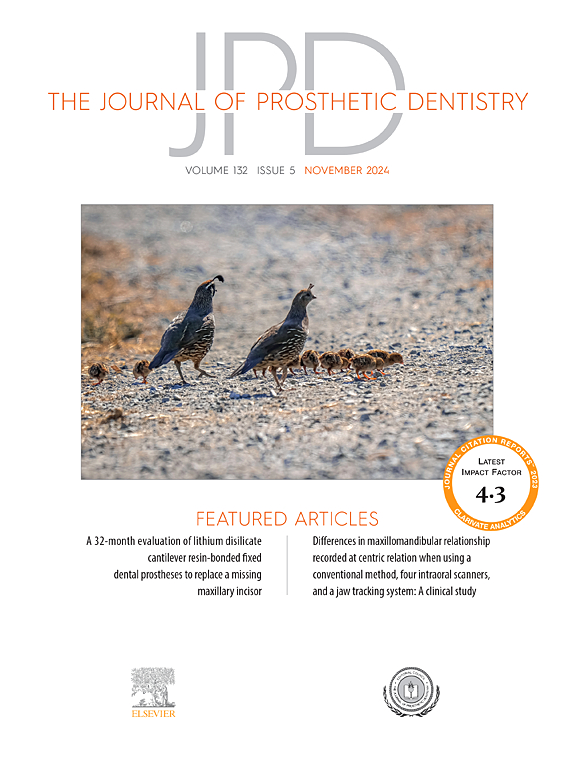Accuracy of tooth color determination by dental students using daylight-calibrated dental operatory lighting sources
IF 4.3
2区 医学
Q1 DENTISTRY, ORAL SURGERY & MEDICINE
引用次数: 0
Abstract
Statement of problem
Lighting conditions are an essential factor for accurately determining tooth color. However, the ideal lighting conditions for determining tooth shade are rarely met and are difficult to quantify. While the use of a standardized daylight lamp D55 can improve accuracy, its high cost limits its use in dental offices. The use of modern operatory treatment units for tooth color determination is promising, as they now allow for the adjustment of light source settings such as color temperature and intensity. However, studies are needed to determine whether they provide accurate color determination.
Purpose
The purpose of this study was to assess the accuracy of visual tooth shade determinations under the adjusted light sources of 2 different dental treatment units in comparison with a standardized daylight lamp D55.
Material and methods
Dental treatment units from 2 manufacturers KaVoLUX 540 LED (LK) and LEDview Plus (LDS) were tested. The light sources of these units were adjusted to match daylight conditions. A daylight lamp (Dialite Color 7; Eickhorst & Co. KG) was used as a control (D55). A total of 49 participants (median age of 25 years, 30 women) underwent the Ishihara screening and received standardized training calibration. A total of 2205 clinical visual tooth shade determinations were performed with the Toothguide Training Box using the Vita 3D-Master shade guide under the 3 different lighting types. Each participant had 15 color determinations made under each of the 3 light settings. Color differences were analyzed by using the Kruskal-Wallis, Wilcoxon rank-sum, and chi-squared tests (α=.05).
Results
The type of lighting used for tooth shade determination had no significant effect on the accuracy of selected shade based on the ΔE00 metric (P=.133). Perfect matches were achieved in 50.8% of the cases under LK, 49.8% under LDS, and 53.6% under D55 light, with no significant difference among percentages (P=.315). Although there was a significant difference in time elapsed for shade determination by light type (P=.004), this difference was not clinically relevant (20.8 seconds for LK, 23.9 seconds for LDS, 21.9 seconds for D55).
Conclusions
The accuracy of color determination for both examined dental operatory lamps was found to be comparable with that of the standard D55 daylight lamp when adjusted to specific settings.
牙科学生使用日光校准的牙科手术照明光源测定牙齿颜色的准确性
问题陈述照明条件是准确确定牙齿颜色的基本因素。然而,确定牙齿色泽的理想照明条件很少能达到,也很难量化。虽然使用标准日光灯 D55 可以提高准确性,但其昂贵的价格限制了其在牙科诊所的使用。使用现代手术治疗设备来确定牙齿颜色是很有前景的,因为它们现在可以调整色温和强度等光源设置。本研究的目的是评估在 2 种不同的牙科治疗设备的调节光源下,与标准日光灯 D55 相比,目测牙色测定的准确性。材料和方法 测试了 2 家制造商生产的牙科治疗设备:KaVoLUX 540 LED(LK)和 LEDview Plus(LDS)。这些设备的光源都经过调整,以符合日光条件。日光灯(Dialite Color 7; Eickhorst & Co. KG)作为对照(D55)。共有 49 名参与者(中位年龄为 25 岁,30 名女性)接受了石原筛查,并接受了标准化培训校准。在 3 种不同的光照条件下,使用 Vita 3D-Master 牙色引导仪,使用牙色引导仪训练箱进行了总计 2205 次临床视觉牙色测定。每位参与者在 3 种光线设置下各进行了 15 次颜色测定。使用 Kruskal-Wallis、Wilcoxon 秩和和卡方检验(α=.05)对颜色差异进行分析。结果根据 ΔE00 指标(P=.133),用于确定牙色的照明类型对所选牙色的准确性没有显著影响。在 LK 灯光下,50.8% 的病例实现了完美匹配,在 LDS 灯光下,49.8% 的病例实现了完美匹配,在 D55 灯光下,53.6% 的病例实现了完美匹配,各百分比之间无显著差异(P=.315)。虽然不同光源在确定色调的时间上有显著差异(P=.004),但这种差异与临床无关(LK 为 20.8 秒,LDS 为 23.9 秒,D55 为 21.9 秒)。
本文章由计算机程序翻译,如有差异,请以英文原文为准。
求助全文
约1分钟内获得全文
求助全文
来源期刊

Journal of Prosthetic Dentistry
医学-牙科与口腔外科
CiteScore
7.00
自引率
13.00%
发文量
599
审稿时长
69 days
期刊介绍:
The Journal of Prosthetic Dentistry is the leading professional journal devoted exclusively to prosthetic and restorative dentistry. The Journal is the official publication for 24 leading U.S. international prosthodontic organizations. The monthly publication features timely, original peer-reviewed articles on the newest techniques, dental materials, and research findings. The Journal serves prosthodontists and dentists in advanced practice, and features color photos that illustrate many step-by-step procedures. The Journal of Prosthetic Dentistry is included in Index Medicus and CINAHL.
 求助内容:
求助内容: 应助结果提醒方式:
应助结果提醒方式:


